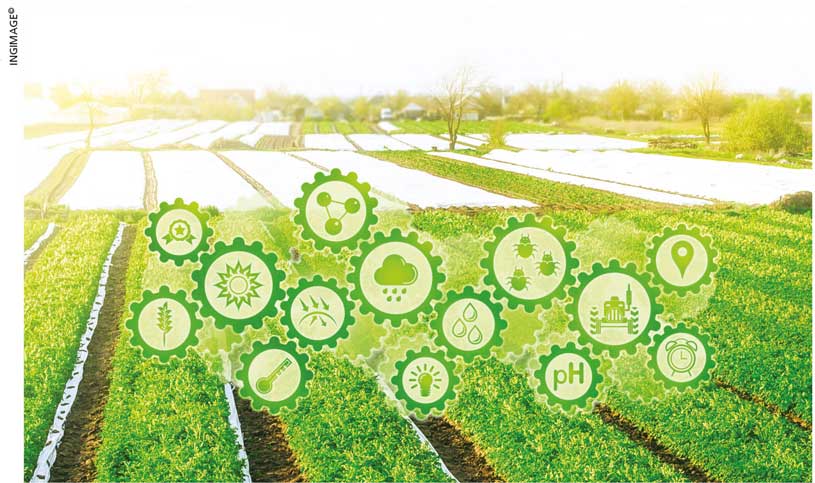AGRICULTURE SECTOR
GAINS FROM SMART FARMING
Akila Wijerathna sees valuable contributions made by tech in agriculture

Precision agriculture technologies are helping farmers make substantial gains in agricultural sustainability despite being hugely challenged by climate change and the COVID-19 pandemic.
This entails ‘smart agriculture’ that applies high-tech systems such as controlled traffic farming and autonomous tools, which include agricultural robots, GPS, yield mapping, remote sensing techniques, auto steering, drones, variable rate technology, and AI and IoT deployments.
These systems should ideally enable farmers to increase yields, save nutrients and replace labour time, with efficient sensing and decision-making support systems, which in turn can increase profitability on farms and reduce their negative environmental footprint.
As a result, precision agriculture can have positive environmental and economic impacts by increasing productivity and crop yields; managing water; efficiently using fertilisers and herbicides; and reducing fossil fuel usage, carbon emissions and post-harvest losses.
Precision agriculture provides farmers with the tools, data and resources needed to make critical decisions about their crops. In addition, this facilitates increasing crop yields and profits, by measuring and analysing critical data points using the latest tools and technology.
Farmers collect data from their fields using sensors, and map it with other information such as weather forecasts to make field level decisions about when, where and how much chemical application they should undertake.
Precision agriculture has been shown to reduce environmental impacts while increasing farmers’ revenues without requiring more extensive upfront investments in expensive equipment or labour hours.
As advancements in technology enable further efficiency and productivity gains, the economic case for controlled environment agriculture (CEA) is likely to become more substantial for crops that are well suited to these cultivation techniques.
CEA combines the best aspects of precision agriculture with an indoor approach to farming where crops are grown inside to monitor quality control, safety and security.
It creates sustainable and optimised growing conditions for crops while protecting them from pests or disease. It’s part farm and part science lab, and wholly devoted to high quality crop yields.
Although grain crops and pulses require large fields, tomatoes, cucumbers, peppers, leafy greens, microgreens, herbs and strawberries are some of the many fruits and vegetables that thrive indoors under precisely controlled conditions.
Challenging labour supply in key growing regions, unpredictable weather, climate change, consumer trends, retailers diversifying year-round supply and economically feasible technology growth have contributed to the recent increase in CEA.
Further, the legalisation of cannabis has created a greater demand for CEA to cater to rapid market growth.
Greenhouses and urban farm factories are expensive to set up but pay off through higher yields, quality and market value since production can take place throughout all seasons. While the US, Israel, Spain and the Netherlands are global leaders in adopting CEA, the rest of the world is also showing a great interest in implementing it.
The Netherlands is the third largest vegetable exporter globally (US$ 8.2 billion in 2019), the US leads with 15.1 billion dollars and Spain comes second with US$ 9.9 billion.
Precision agriculture depends on individual operations, types of crops, scale, markets, consumers and geographical location. But more importantly, its technologies are employed to replicate the natural environment at the lowest possible cost.
For instance, vertical farming is the most popular system where crops are grown on stacked units in warehouses, underground tunnels or even shipping containers, and require artificial lighting – usually by using expensive LEDs to mimic sunlight.
But some operators, particularly in hot areas such as the Middle East and Asia, grow crops in high-tech greenhouses using primarily natural light.
Nonetheless, even growers in such hot climates need LED lighting to supplement daylight hours. All controlled environment farming requires labour, ventilation, irrigation and cooling, as well as massive capital investment to purchase land, establish farms, install appropriate technology and run them.
Despite the costs however, indoor farming is viewed through a longer-term lens to address environmental concerns such as the decreasing availability of land, unpredictable weather patterns and climate change, and limited resources on hand to feed the world’s growing population.
Precision agriculture is part of the solution to feed the growing global population in spite of limited resources while ensuring sustainable water and energy use. Given the proper financial and policy support, private corporations will be able to explore the opportunities out there and invest where needed.



